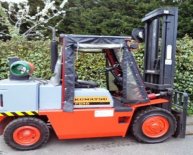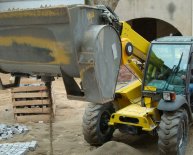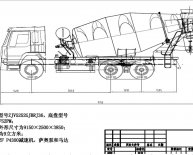
Tools used for mixing Concrete
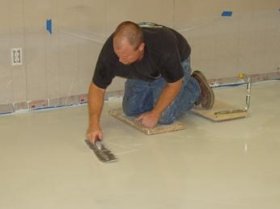 1. Hand TrowelsThe same finishing trowels used for finishing concrete can also be used for skim coats and overlays. Hand trowels come in many shapes and sizes. For example, some technicians prefer using a square-edged trowel while others choose to use a pool trowel, which has rounded edges. Typically hand trowels range from 4 to 24 inches in length. They can be used to distribute material across the floor from one location to the next, with the primary function being to smooth or texture the topping. The angle of the trowel and how much pressure you apply will determine how thick and smooth the surface will be.
1. Hand TrowelsThe same finishing trowels used for finishing concrete can also be used for skim coats and overlays. Hand trowels come in many shapes and sizes. For example, some technicians prefer using a square-edged trowel while others choose to use a pool trowel, which has rounded edges. Typically hand trowels range from 4 to 24 inches in length. They can be used to distribute material across the floor from one location to the next, with the primary function being to smooth or texture the topping. The angle of the trowel and how much pressure you apply will determine how thick and smooth the surface will be.
Tips and techniques: Many different techniques can be used with hand trowels, like skip troweling to create texture or random trowel strokes to create interesting effects. To gain confidence before using hand trowels to finish a paying client's floor, make sample boards using a variety of trowels along with different techniques. Remember, the more you practice, the more proficient you become.
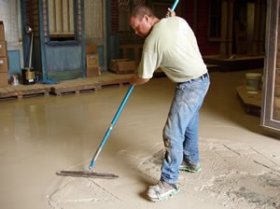 A funny trowel attached to a pole permits
A funny trowel attached to a pole permits
troweling from a standing position.
2. Funny Trowels and FresnosThese types of tools are attached to the end of a pole and are most commonly used for stampable overlays. Having the funny trowel or fresno on a handle allows you to stand upright while finishing the topping, unlike hand trowels, which require you to work on your knees. When using a funny trowel, the troweling direction is usually left to right or arced, whereas the fresno is commonly pushed straight out in front of you and then directly back.
Tips and techniques: Regardless which of these tools you use, one thing is very important: Don't overwork or over trowel the surface. When you trowel over stampable overlays multiple times, air and moisture become trapped beneath the surface paste, which can cause blisters. For this reason, it's best to trowel the surface one time only and then let the material stiffen until it's time for the stamping phase. If you have never used these types of tools, don't plan on mastering them overnight.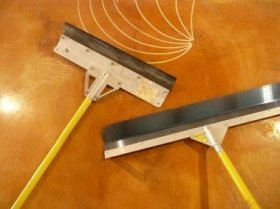 It takes plenty of practice and finesse to work with them, since the amount of pressure you apply and the timing are crucial.
It takes plenty of practice and finesse to work with them, since the amount of pressure you apply and the timing are crucial.
Examples of rubber (left) and metal (right) squeegees.
3. SqueegeeSqueegees are by far the fastest way to apply microtoppings and bond coats. Although some applicators use small handheld squeegees while working on their knees, predominately they are used while standing upright. Like hand trowels, they come in a wide variety of shapes and sizes. Some applicators prefer using metal squeegees while others prefer rubber. Applying products in this fashion usually produces a surface that is not as smooth and uniform as hand troweling. In most cases, this is fine since a second coat of material will be applied over the first coat.
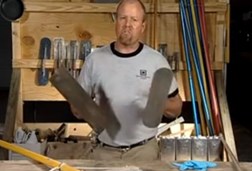 Tips and techniques: If ridges have been left behind as a result of going too fast or using the improper technique, don't fret. A quick sanding with sandpaper or a sanding screen will smooth out any imperfections. The amount of pressure you apply while squeegeeing depends on the viscosity of the material you are using and the profile of the concrete. If your material is mixed thinly, this will increase the square-foot coverage rate. Thicker materials tend to yield less coverage. Be sure to check your overlay manufacturer's recommendations for mix ratios and application considerations.
Tips and techniques: If ridges have been left behind as a result of going too fast or using the improper technique, don't fret. A quick sanding with sandpaper or a sanding screen will smooth out any imperfections. The amount of pressure you apply while squeegeeing depends on the viscosity of the material you are using and the profile of the concrete. If your material is mixed thinly, this will increase the square-foot coverage rate. Thicker materials tend to yield less coverage. Be sure to check your overlay manufacturer's recommendations for mix ratios and application considerations.
Magic Trowel Concrete Resurfacing Video
Time: 03:50
Tips & techniques for using a concrete trowel, magic trowel, skimmer or squegees to apply overlays.
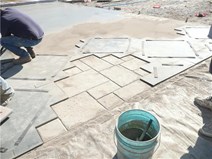 4. Magic TrowelThe magic trowel can technically be considered a squeegee. However, it seems to have earned its own category as a stand-alone tool and has become the tool of choice for many installers. This tool, which got its start in applying faux finishes to plaster walls, is more of a "finesse" tool. Its distant relative, the squeegee, is used for larger and faster applications, like driveways, while the magic trowel lends itself to producing a more refined floor. The rubber blade is much thinner and somewhat flexible when compared to a traditional squeegee. The direction you work with this tool depends on the desired effects. We will sometimes use a left-to-right long, sweeping motion, while other times we use an overlapping rainbow pattern while smoothing.
4. Magic TrowelThe magic trowel can technically be considered a squeegee. However, it seems to have earned its own category as a stand-alone tool and has become the tool of choice for many installers. This tool, which got its start in applying faux finishes to plaster walls, is more of a "finesse" tool. Its distant relative, the squeegee, is used for larger and faster applications, like driveways, while the magic trowel lends itself to producing a more refined floor. The rubber blade is much thinner and somewhat flexible when compared to a traditional squeegee. The direction you work with this tool depends on the desired effects. We will sometimes use a left-to-right long, sweeping motion, while other times we use an overlapping rainbow pattern while smoothing.

